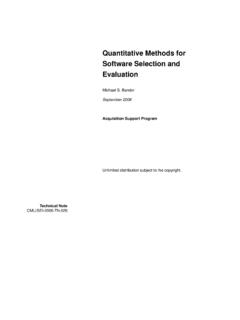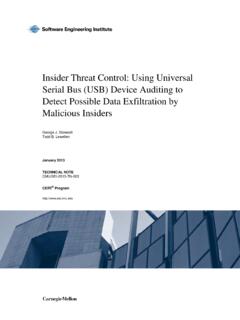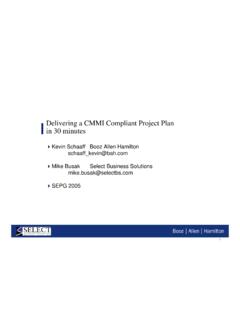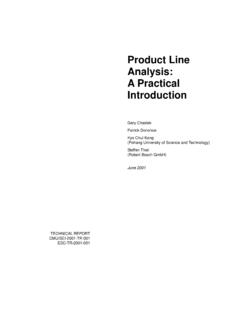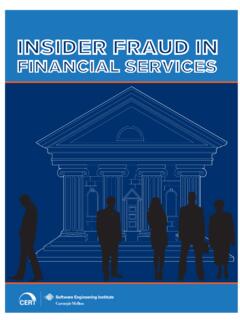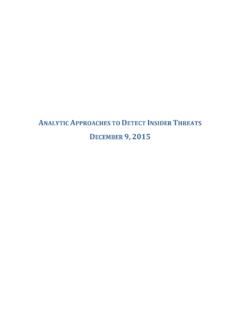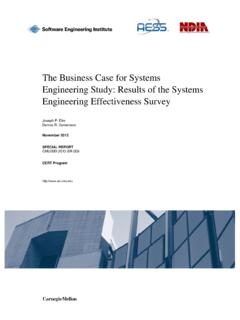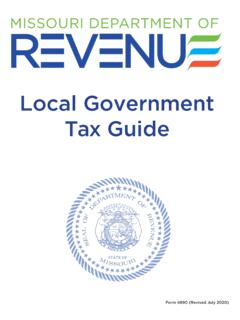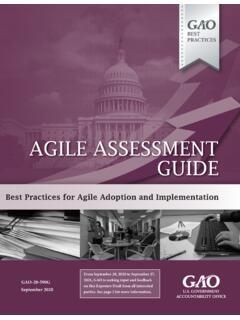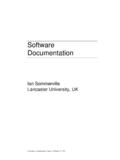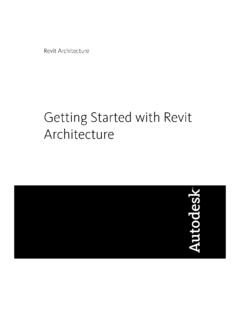Transcription of Documenting Software Architecture: Documenting Interfaces
1 Documenting Software Architecture: Documenting InterfacesFelix BachmannLen BassPaul ClementsDavid GarlanJames IversReed LittleRobert NordJudith StaffordJune 2002 TECHNICAL NOTECMU/SEI-2002-TN-015 Pittsburgh, PA 15213-3890 Documenting Software Architecture: Documenting InterfacesCMU/SEI-2002-TN-015 Felix BachmannLen BassPaul ClementsDavid GarlanJames IversReed LittleRobert NordJudith StaffordUnlimited distribution subject to the 2002 Architecture Tradeoff Analysis InitiativeThe Software Engineering Institute is a federally funded research and development center sponsored by the Department of 2002 by Carnegie Mellon WARRANTYTHIS CARNEGIE MELLON UNIVERSITY AND Software ENGINEERING INSTITUTE MATERIAL IS FURNISHED ON AN AS-IS BASIS.
2 CARNEGIE MELLON UNIVERSITY MAKES NO WARRANTIES OF ANY KIND, EITHER EXPRESSED OR IMPLIED, AS TO ANY MATTER INCLUDING, BUT NOT LIMITED TO, WARRANTY OF FITNESS FOR PURPOSE OR MERCHANTABILITY, EXCLUSIVITY, OR RESULTS OBTAINED FROM USE OF THE MATERIAL. CARNEGIE MELLON UNIVERSITY DOES NOT MAKE ANY WARRANTY OF ANY KIND WITH RESPECT TO FREEDOM FROM PATENT, TRADEMARK, OR COPYRIGHT work was created in the performance of Federal Government Contract Number F19628-00-C-0003 with Carnegie Mellon University for the operation of the Software Engineering Institute, a federally funded research and development center. The Government of the United States has a royalty-free government-purpose license to use, duplicate, or disclose the work, in whole or in part and in any manner, and to have or permit others to do so, for government purposes pursuant to the copyright license under the clause at Internal use.
3 Permission to reproduce this document and to prepare derivative works from this document for internal use is granted, provided the copyright and No Warranty statements are included with all reproductions and derivative use. Requests for permission to reproduce this document or prepare derivative works of this document for external and commercial use should be addressed to the SEI Licensing of any trademarks in this report is not intended in any way to infringe on the rights of the trademark holder. For information about purchasing paper copies of SEI reports, please visit the publications portion of our Web site ( ).Table of ContentsCMU/SEI-2002-TN-015iAbstract .. v1 Introduction .. 12 Overview .. 23 Terminology: Signature, API, and Interface.
4 54 Interface Specification .. 75 A Standard Organization for Interface Documentation .. 106 Stakeholders of Interface Documentation .. 147 Notation .. for Showing the Existence of Interfaces .. for Conveying Syntactic Information .. for Conveying Semantic Information .. Summary .. 198 Examples .. Interface .. Notation .. 319 Summary .. 33 References .. 35iiCMU/SEI-2002-TN-015 List of FiguresCMU/SEI-2002-TN-015iiiFigure 1: Outline of Interface Documentation .. 10 Figure 2: Sample Graphical Notation .. 16 Figure 3: Showing Interfaces Separately .. 17 Figure 4: Showing Syntactic Information About Interfaces in UML.. 18 Figure 5: Introduction of Sample SCR-Style Interface.
5 21 Figure 6: Interface Overview of Generator Access Program ++gen++.. 22 Figure 7: Interface Overview of Access Programs of Generated Module (excerpt) .. 22 Figure 8: Effects of Program +add_first+ Shown in Figure 7 .. 23 Figure 9: Locally Defined Data Types (excerpt) .. 23 Figure 10: Dictionary (excerpt) .. 24 Figure 11: Exceptions Dictionary (excerpt).. 24 Figure 12: System Configuration Parameters (excerpt) .. 25 Figure 13: Design Issues, Implementation Notes, and Assumptions (excerpt) .. 26 Figure 14: An Example of IDL for an Element in a Banking Application [Bass 98, pg. 177] .. 27 Figure 15: Example of Documentation for an Interface Resource, Taken from the HLA [IEEE 00, pg. 104] .. 29 Figure 16: Sample Statechart.
6 30 Figure 17: Sample Data Element, a Personal Record .. 31ivCMU/SEI-2002-TN-015 CMU/SEI-2002-TN-015vAbstractThis is the fourth in a series of Software Engineering Institute reports on Documenting soft -ware architectures. This report details guidance for Documenting the Interfaces to Software ele-ments. It prescribes a standard organization (template) for recording semantic as well as syntactic information about an interface. Stakeholders of interface documentation are enumer-ated, available notations for specifying Interfaces are described, and three examples are report represents another milestone of a work in progress. That work is a comprehensive handbook on how to produce high-quality documentation for Software architectures.
7 The handbook, titled Documenting Software Architectures: Views and Beyond, will be published in August 2002 by Addison Wesley Longman Inc. as part of the SEI Series on Software Engi-neering. The book is intended to address a lack of language-independent guidance about how to capture an architecture in a written form that can provide a unified design vision to all the stakeholders on a development project. The book is aimed at the community of practicing architects, apprentice architects, and developers who receive architectural previous reports laid out our approach and organization for the complete book and pro-vided self-contained previews of individual chapters. The first provided guidance for one of the most commonly used architectural views: the layer diagram [Bachmann 00].
8 The second laid out a structure for a comprehensive architecture documentation package [Bachmann 01]. The third prescribed documentation approaches for describing the behavior of Software [Bach-mann 02].1 The material in this document assumes familiarity with the language and concepts introduced in these earlier technical note describes ways to document an important, but often overlooked, aspect of Software architecture: the documentation of Software these reports are snapshots of work in progress, the book may reflect and incorporate various changes in the details,but not in treatments of architecture and architecture-description languages devoted loving atten-tion to the elements of Software systems and their interactions but tended to overlook the inter-faces to those elements.
9 It was as though Interfaces were not part of the architecture. Clearly, however, Interfaces are supremely architectural, for one cannot perform analyses or system building without them. Therefore, a critical part of Documenting a view includes Documenting the Interfaces of the elements shown in that view. What is an interface? Various communities use various definitions, but we use the following one:An interface is a boundary across which two independent entities meet and interact or communicate with each characteristics of an interface depend on the view type of its element. If the element is a component, the interface represents a specific point of its potential interaction with its environ-ment. If the element is a module, the interface is a definition of services.
10 There is a relation between these two kinds of Interfaces , just as there is a relation between components and the element s environment, we mean the set of other entities with which it interacts. We call those other entities actors:An element s actors are the other elements, users, or systems with which it general, an actor is an abstraction for external entities that interact with the system. Here, we focus on elements and expand the definition of interaction to include anything one element does that can impact the processing of another element. This interaction is part of the ele-ment s interface. Interactions can take a variety of forms. Most involve the transfer of control and/or data. Some are supported by standard programming-language constructs, such as local or remote procedure calls (RPCs), data streams, shared memory, and message constructs, which provide points of direct interaction with an element, are called resources.
